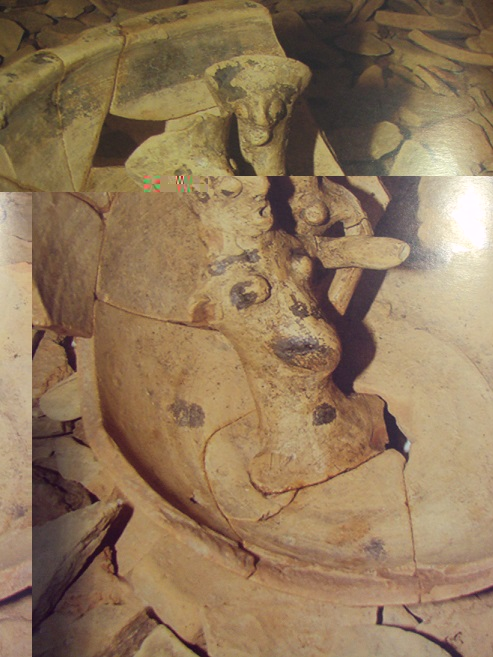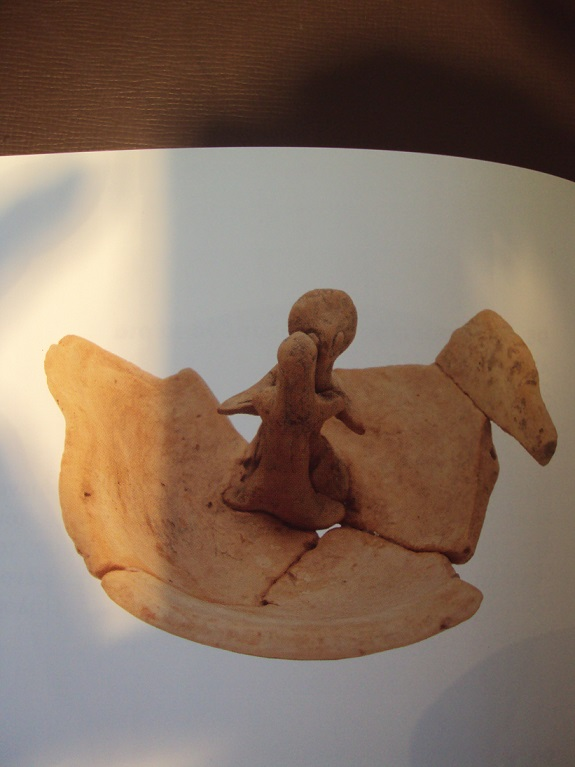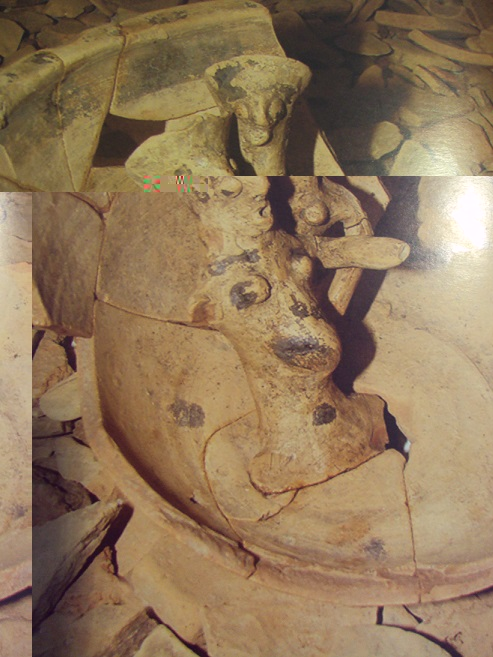Page 1 of 2
Mother's Day
Posted: Sun May 10, 2015 12:22 pm
by system1988
Hi all
From the book "ΕΛΟΥΘΙΑ ΧΑΡΙΣΤΗΙΟΝ. Το ιερό σπήλαιο της Ειλειθυίας στον Τσούτσουρο
Edited by Athanasia Kanta & Costis Davaras" - all photos posted on this thread by me are from this book.
Here is a vase with sculpted decoration of a scene of a woman giving birth. It is hypothesized that the one helping the pregnant woman is the godess of childbirth Ειλείθυια (Ilithia). From the sacred cave of the godess in the village Tsoutsouro in Crete.
Mid 9th- early 8th BC.

- DSC03830.JPG (148.5 KiB) Viewed 5668 times
Best
Pauline
Re: Mother's Day
Posted: Sun May 10, 2015 5:33 pm
by hiphys
Really impressive! I never saw anything similar! Thanks for sharing.
Re: Mother's Day
Posted: Mon May 11, 2015 2:15 pm
by system1988
Yes it is impressive as far as the technique and theme-wise. The vase itself is actually a basket "κάλαθος" 9,7cm high and 17,5 cms in diameter. The only characteristics given are the genetelia of the mother to be. In his attempt to show the movement, the aritst gave too long arms to the figures.
The Eileithia godess which is the ancient greek verb "ελεύθω" which in turn means "rush to the aid of someone"was worshiped in ancient Crete as Ελευσία (Eleusia)
thank you very much for your comment
Re: Mother's Day
Posted: Tue May 12, 2015 6:23 pm
by sikander
Greetings
Thank you for sharing this.. I had seen Eileithyia/Ilithyia et al on vases but not in a three dimensional form...
Regards,
Sikander
Re: Mother's Day
Posted: Thu May 14, 2015 12:06 am
by Xenophon
Thank you for sharing this ! What strikes me immediately is that it obviously portrays giving birth in a bath or 'birthing pool', which is a (supposedly) relatively modern technique. To learn that it is in fact a very ancient technique is most interesting....
Re: Mother's Day
Posted: Thu May 14, 2015 6:57 pm
by sean_m
Thanks for the picture! I did not know that figurine.
Apparently some of the authors on gynaecology who nobody reads any more describe the use of birthing stools. One of my colleagues in Calgary was working on one of them. Eric Shanower depicts a birth with the aid of one in one of the early Age of Bronze volumes.
Re: Mother's Day
Posted: Thu May 14, 2015 8:08 pm
by system1988
sikander wrote:Greetings
Thank you for sharing this.. I had seen Eileithyia/Ilithyia et al on vases but not in a three dimensional form...
Regards,
Sikander
Thank you for your kind comment, the Eileithia's depiction is already scarse enough in paintings.
Re: Mother's Day
Posted: Thu May 14, 2015 8:13 pm
by system1988
Xenophon wrote:Thank you for sharing this ! What strikes me immediately is that it obviously portrays giving birth in a bath or 'birthing pool', which is a (supposedly) relatively modern technique. To learn that it is in fact a very ancient technique is most interesting....
Thanks for your comment as well! Your observation is original but I do not believe we have a birth scene in water, firstly because we have more representations which I will post tomorrow (coitus) which cannot be carried out in water (conventionally speaking

) and secondly we have no written sources in the entire spectrum of ancient Greece that would support such a claim.
Re: Mother's Day
Posted: Thu May 14, 2015 8:16 pm
by system1988
sean_m wrote:Thanks for the picture! I did not know that figurine.
Apparently some of the authors on gynaecology who nobody reads any more describe the use of birthing stools. One of my colleagues in Calgary was working on one of them. Eric Shanower depicts a birth with the aid of one in one of the early Age of Bronze volumes.
Thanks for your comment and the info, however in this case there is no stool or chair. Nevertheless I have a vague impression that there are scenes in vases which deprict the use of chairs during birth but I cannot verify this at the momment.
Re: Mother's Day
Posted: Thu May 14, 2015 9:23 pm
by agesilaos
I wonder if rather too much has been read into this. I do see that there appears to be a vagina, but there is no swollen belly nor any breasts, both indicators of a pregnant woman. Now, if there are similarly posed figures, in whatever medium, then I disown my skepticism, but given the crude work might that, seemingly essential female attribute just not be where the artist's thumb or finger nail has moulded the clay while adding the legs. I was under the impression that most birth were with the mother either standing or crouching in early society (though I confess to a great deal of squeamishness, I can watch any amount of torture and disembowelling but ' The Miracle of Birth'...tell me when it's over!)

Were both figures male it might be a fallen warrior, surely a more likely subject in a phallocentric society? nor does it seem obvious just what this object was used for; it is not glazed so cannot have held liquid, this I know from having made an unglazed clay mug and trying to drink from it! Fortunately, I was eight and the liquid was but water. It may have held dry offerings to the goddess or hero, Persius mentions the Gods being more favourable to a good man's offering of a handful of wheat than a bad man's cow in one of his Satires (the wheat is right but the ow may be an error, Persius is no comedian; for that read Juvenal or Martial, more laughs than a Jacobean Tragedy

).
Is there more info in the notes, Pauline? It is certainly interesting, as all have said, and I have not seen anything comparable, though that is not saying too much

Re: Mother's Day
Posted: Thu May 14, 2015 10:37 pm
by system1988
For Agesilaos
A small taste for what is to come

- DSC04782.jpg (144.66 KiB) Viewed 5588 times
Μογοστόκοι Ειλειθιαι...
the godesses Eilithiai which bring great pain... (to women on childbirth)
Homer Iliad T ( 19) 76- 138
Pauline
Re: Mother's Day
Posted: Thu May 14, 2015 11:19 pm
by Alexias
agesilaos wrote: I do see that there appears to be a vagina, but there is no swollen belly nor any breasts, both indicators of a pregnant woman.
There is a swelling below the crossed arms, although the top of it appears damaged. There is also the ghost of a face on the pregnant woman, slightly better defined on the supporter. The position of the arms does seem to indicate extremis, either pleasure or pain.
Re: Mother's Day
Posted: Sat May 16, 2015 5:15 pm
by system1988
As far as the observation made by Alexias there indeed is a swelling in the belly area and the "damage" on it is from the second hand of the godess who touched the mother-to-be with both. The figures are very weathered but in their original frorm they had open spaces for their eye sockets and most surely more detail. The fact that this is Eileithia godess is proven by the fact that in the same cave vases were found that bear her name in LInear II.
Indeed the worshiping of the godess commenced in that cave since Minoan times and lasted up till Roman times. Concerning the figurines on vases themselves they are mainly from the protogeometric era and included the entire circle of life: Flirting (!), Coitus, Birth, and the child itself.
The first 3 photos are from the flirting stages so-to-say. See below.

- 3.JPG (116.48 KiB) Viewed 5560 times

- 2.JPG (121.33 KiB) Viewed 5560 times

- 1.JPG (93.85 KiB) Viewed 5560 times
Re: Mother's Day
Posted: Sat May 16, 2015 5:32 pm
by system1988
This is part 2 of my reply, photo size allows only 3 photos per post and I have 3 more to show you
First photo is the coitus stage. The woman is the taller one and wears some sort of hat. The peculiar part is that she is already pregnant but there is coitus maybe so that the fetus can be strengthed by more semen, according to an ancient belief, as the book writers suggest. Some fantasy is needed of course to see the coitus part which is mainly focus around the leg area.

- 4.JPG (111.56 KiB) Viewed 5560 times
The second photo which I have alerady sent as a preview has a lot more detail. The godess' hand is on the neck of the mother-to-be whose face expresses pain through the open mouth.

- 5.jpg (144.66 KiB) Viewed 5560 times
The last photo is the "kourotrofos" which means the woman who feeds the child. It's an archetypical form with thousands of years behind it as well as thousands of years in front of it as far as art history goes.
As far as Agesilaos' observation about the "random" engraving goes no, it's not random at all. It just depicts with all its possilbe accuracy the female genitalia as we have seen on other figurines of that era.
I wrote and sent all this in order to answer to some excused queries which also came up excusably due to the appearance and bad preservation of the artifacts. Hope it helped.
Re: Mother's Day
Posted: Sat May 16, 2015 8:05 pm
by agesilaos
It certainly makes sense within the context of the group and since the breasts and belly may well have been stuck on separately and subsequently lost. In English we say Linear B, I realise you have Linear Beta and that beta is also II as well as 'B'. How widespread was this cult? Can you say